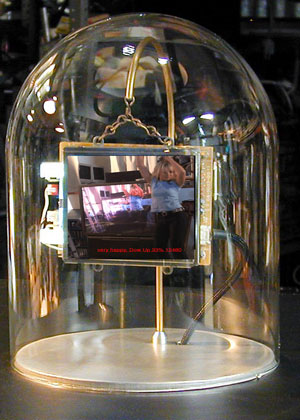While characterizing digital art materials for long-term preservation is laced with considerable complexity, it offers insights applicable to the preservation of all kinds of contemporary and emerging materials. The Planets project (Preservation and Long-term Access through Networked Services) is leading research into emerging characterization approaches that will safeguard the availability of diverse digital experiences.
As part of its contribution to the Planets project, the Humanities Advanced Technology and Information Institute (HATII) at the University of Glasgow is creating vocabularies and information structures for adequately characterizing the value of digital art. Value is encompassed in those qualities that must be understood and captured in order to ensure that art works' sensory, emotional, mental and spiritual resonance remain. Facets of interactivity, modularity and temporality associated with digital art present critical questions that the preservation community must acknowledge; HATII and Planets' intention is to highlight risks and approaches that may be applicable to a wider, more generic range of materials. A definitive ontological model for characterizing the many relevant facets of new media is being conceived; because digital art materials exhibit fundamental multidimensionality, validating the preservation of creative experience demands the explication of more than just file characteristics. Understanding relationships between objects also implies an understanding of their respective functional qualities. By aiming to solve some of the more difficult issues of digital persistence within this notably challenging domain, we hope to highlight future research directions that could accommodate the increasingly complex digital infrastructures of tomorrow.
Art communicates simultaneously on sensory, emotional, mental and spiritual levels. For digital art, these levels of impact and our comprehension of value are based not just on tangible characteristics of the piece in question, but on many additional contextual factors that may be permanent or transitory, localized or global and either physical or conceptual. Furthermore, those qualities considered more intrinsic to works may be difficult to characterize. Contemporary art typically establishes, encourages and demands greater levels of dialogue than the traditional fruits of creativity. Whereas paintings or sculptures are largely consumed in a passive manner by audiences, digitally equipped installations (most obviously net art) promote a high degree of often distributed user involvement. Meaning is less than self-evident; unlike more traditional art where the materials used are largely subservient to the implicit message, it is commonplace within contemporary works for specific component materials to have tremendous implications for the overall meaning. These issues are shared by digital materials more generally - they regularly exhibit complexity of interpretation, consumption and application in excess of those physical materials with implicit, unambiguous usefulness. Of critical importance is the extent to which information and the associated means of representation or experience are tightly or loosely coupled. Numerous logical and physical layers must exist to support the presentation and understanding of digital information: this is in contrast to analogue information, which exists largely atomically. More layers introduce more complex dependencies between those layers; any preservation action (to alter the format of a digital image component for example) can have implications far in excess of the intended extent of the intervention. From the artist’s perspective, complexity creates opportunities for variation of behaviour and performance. While this contributes to, rather than detracts from, the significance and impact of the creative expression, it introduces difficulties for those seeking to characterize and preserve that which is definitive in and around a digital work.

Figure 1: Lynn Hershman Leeson’s ‘Synthia’. In this work the mannerisms of an animated character rendered onscreen are influenced by live stock market data.
Further complications arise from the often modular nature of contemporary installations, whereby components operate based on inputs from discrete linked systems. Lynn Hershman Leeson’s ‘Synthia’ is a good example. In this work the mannerisms of an animated character rendered onscreen are influenced by live stock market data. Partly contextual, partly intrinsic, the flow of data must be made persistent for the piece to be correctly exhibited. We see similar phenomena within the digital context more generally; applications and file formats are increasingly networked, and are more and more reliant on decentralized services. How we deal with the preservation challenges associated with maintaining third-party services or user contributions is particularly challenging. Web archiving appears trivial when dealing with simple networks of linked, static Web pages. When the relationships between scripts, users, Web services, databases and rights management systems become more intricate and integral, preservation becomes less akin to photocopying and more like performing organ transplant surgery, with all of the risks that digital materials will be ‘rejected’ within their anticipated preservation environment.
From the conservator’s perspective, documentation takes on a critical role. In those cases where art relies on bespoke, deteriorating materials, externally managed and originating services or a critical mass of community involvement there may be no way to ensure its availability. Nevertheless, the maintenance of appropriate linkable and navigable documentation can assist conservation and preservation strategies, most notably offering opportunities to characterize value and formulate priorities for individual examples. This can then inform the selection of subsequent conservation or restoration strategies, and ensure their consistency with the spirit of the piece.
This work was funded by the Planets (IST-2006-033789) Project, funded by the European Commission’s IS&T 6th Framework Programme.
Links:
http://www.planets-project.eu/
http://www.hatii.arts.gla.ac.uk/
Please contact:
Andrew McHugh
University of Glasgow, UK
Tel: +44 141 330 2675
E-mail:










